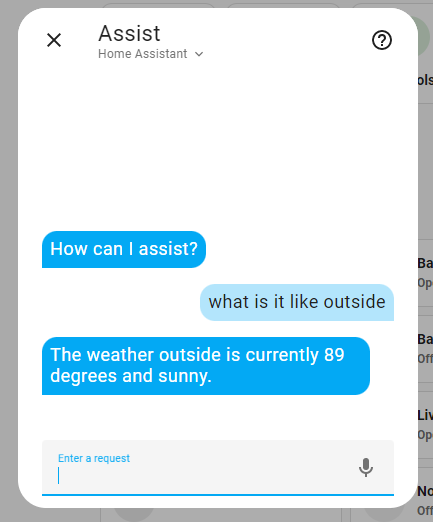Custom Jinja Templates in Home Assistant
I have a Home Assistant automation that reads out some information each morning utilizing text-to-speech with Piper. One of the first things it says is the current date and day of the week. My big problem is that the text to speech engine is not very good at pronouncing dates. What I want is “today is Monday, September 1, 2025” with the date read as “first”. What I get is the date read as “September one”. The is a real first world dude-with-too-much-time-on-his-hands sort of problem but it does bother me. It’s a bit jarring to hear and seems like the sort of thing that should just work.
Of course the problem is two fold. The first is that the date parsing code sends the sentence with the number 1 instead of the written out word first or even 1st. This is an issue with the date translation working for the written word but not how it’s spoken. The second is that the text-to-speech system doesn’t know this is a date. It just sees a number and reads it. Utilizing some custom template macros I decided to try and fix this issue in a re-useable way.
Local LLM RAG Sync
Anyone with a home lab is playing around with local large language models via Ollama, and I’m no exception. I have a pretty modest setup using Ollama and Open WebUI to run some smaller parameter models. Once the novelty of asking it stupid questions, within the privacy of the fully local setup, ran out I started thinking “how can I get this to do something useful?”. Naturally Retrieval Augmented Generation (RAG) came to mind. Have the system put my own data to work for me so to speak.
Luckily, Open WebUI has good built in support for this through their Knowledge system. The only speed bump I ran in to was how to keep the local knowledge base up to date. In this post I’ll detail a Python script I wrote to leverage the Open WebUI API to sync files within the RAG Knowledge base system.
Updating Kodi Repository with Ansible
I’m not an Ansible guru but I do use it to automate some tasks in my home lab. It is a real time saver to issue commands from a single interface and not rely on a bunch of hacked together Bash scripts all over the place. Recently I was doing some updates to a custom Kodi repository that I use for testing addons in development. The process was pretty cumbersome and after a while I decided it was time to convert the whole process to an Ansible Playbook.
Below I’ll go through the process of modifying a few scripts and setting up the Ansible playbook. This process can be used as a template for other system automations where a legacy script is being adapted for Ansible.
Automate Brewing With Tilt
As I hobby I like to homebrew beer. Nothing too crazy but just a few cases a couple of times a year. It’s fun to do and makes for a nice gift option for friends and family as well. Recently I starting thinking more about gathering data during the brewing process. Mostly I was interested in temperature as different stages of the brew process require specific temperature ranges. These vary depending on the type of beer but it’s important so you don’t kill the yeast during fermentation. In the past I’ve used a manual thermometer but wanted something more hands off.
I didn’t want to build something myself as there is a great consumer market and DIY space for this type of stuff already. My only real requirement was that I get the information into Home Assistant since that is where I try and keep all my dashboards and data for ease of use. As I spiraled down the rabbit hole of possible options I ended up having to do some on-the-fly thinking to get it all working.
Parsing Nagios Performance Data
Recently I was adding features to Trash Panda, a local monitoring system project I probably never should have started. I thought it might be interesting to do something with the performance data many Nagios plugins send back as part of service check results. Performance data is additional data about the service that can be useful as history for how the service is performing. Stuff like disk space metrics, TCP return times, and other types of numeric values. The format is standardized and could then be easily piped into a database or other storage area for later use. This post documents my efforts from loops within loops to something bordering on efficient.
I do want to note I did try and find a tool for this before building something from scratch. There are some command line tools but nothing in a library format. Since the Trash Panda project is written in Python that’s really what I needed.
Dynamic Pandas Data Slicing
Recently I wanted to modify a Python data analysis script I use regularly at work into more of a general purpose tool. The script uses the Pandas Python library to slice up data in CSV files based on some specific time periods. The issue I had is that these time periods changed often, and I was sick of mucking about in the script to constantly tweak them. I needed a way to specify the time periods at runtime instead of hard coding them.
This turned out to be more complicated than I envisioned so I figured I’d document it all for anyone interested (most likely myself in a year when I forget). Note: this post is not a primer on Pandas, or data slicing, if you want more info on that check the Pandas documentation.
Automatic Cat Feeder
We recently got a second cat. It’s been a lot of fun but one thing I didn’t realize is how much more two cats were going to eat. With one cat a bowl of food lasted 2-3 days before needing refilling, with two it seems to be running low every day. To make matters worse we keep our cat food bowl in the laundry room so the food doesn’t get stolen by the dog. The phrase “out of sight, out of mind” definitely applies here and I’ll be honest they’ve run out of food enough times that something had to change.
I had two options. The first was the easy option - just get a bigger bowl. The second was the fun option - buy or build an automatic cat feeder. Obviously I went with the fun option.
QR Code Media Player
We were recently trying to organize some of the clutter in our home and I started in on the video game and Blue Ray/DVD collection. For Blue Ray/DVDs (henceforth referred to as just DVDs) we’re in the same boat as a lot of households, we just don’t use them. Streaming is a good amount of our media consumption but I take movies we’ve purchased and rip them to our NAS so we can play them back via Kodi. Since the entire collection is digitized what often happens is we look at the DVD rack, select a movie we want, and then find it via Kodi and play it there.
Inspired by many Home Assistant related NFC “jukebox” type projects I thought it would be fun to combine the physical with the digital. I wanted to use the physical disc to trigger the playback of the digital file. Since Kodi has a JSON-RPC API being able to trigger playback based on a tag or code seemed doable.

Monitoring SNMP Traps
In my profession life I recently purchased an Infrasensing Base Unit along with a door contact sensor. These are pretty interesting IoT devices that accept a wide variety of sensors. My intention was to connect this to our network monitoring system, Icinga, to monitor the status of a network cabinet door.
Upon playing around with the device I decided the best way to get timely alerts from the sensor was to utilize SNMP traps instead of polling for the status. While I have a lot of experience polling SNMP systems I’d never dug into traps before. Going down the rabbit hole of getting this going turned in to a pretty neat little project that can be utilized to translate SNMP trap payloads into something Icinga can accept for service checks.

Home Assistant Voice Custom Intents
In 2023 Home Assistant is dedicated to making their smart home platform more capable of text and voice interaction through the Year of the Voice. Essentially this is expanding on the capabilities of Home Assistant to interpret human text and speech into smart home actions. This provides more possibilities for existing voice assistants like Alexa and Google Home; while also providing an alternative through Home Assistant’s own Assist platform.
While a number of built-in intent phrases have been added, I’ve been experimenting with adding my own trigger phrases and intents. For the most part this was just following the documentation however there were a few things that weren’t clear, or just didn’t work as expected. I’m documenting these here for future reference, and for anyone else struggling through the same thing. Hopefully as this part of Home Assistant matures adding these custom actions will become more clear.
